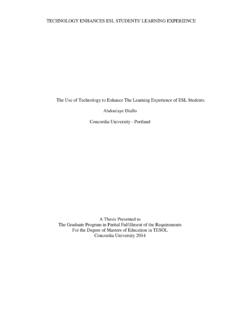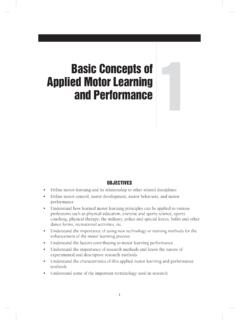Transcription of Developmental Stages of the Learner
1 Developmental Stages of the Learner vitamares/ShutterStock, B. BastableGina M. MyersChapter highLightS Developmental Characteristics The Developmental Stages of Childhood Infancy (First 12 Months of Life) and Toddlerhood (1 2 Years of Age) Early Childhood (3 5 Years of Age) Middle and Late Childhood (6 11 Years of Age) Adolescence (12 19 Years of Age) The Developmental Stages of Adulthood Young Adulthood (20 40 Years of Age) Middle-Aged Adulthood (41 64 Years of Age) Older Adulthood (65 Years of Age and Older) The Role of the Family in Patient Education State of the EvidenceKey termS permanencecausalityprecausal thinkinganimistic thinkingegocentric causationsyllogistic reasoningconservationcausal thinkingpropositional reasoningegocentrismimaginary audiencepersonal fableandragogydialectical thinkingageismgerogogycrystallized intelligencefluid intelligenceChapter 16523/03/13 3:52 PM Jones & Bartlett Learning, LLC.
2 NOT FOR SALE OR DISTRIBUTION6873 When planning, designing, implementing, and evaluating an educational program, the nurse as educator must carefully consider the characteris-tics of learners with respect to their developmen-tal stage in life. The more heterogeneous the target audience, the more complex the development of an educational program to meet the diverse needs of the population. Conversely, the more homo-geneous the population of learners , the more straightforward the approach to individual s Developmental stage signifi-cantly influences the ability to learn. Pedagogy, andragogy, and gerogogy are three different ori-entations to learning in childhood, young and middle adulthood, and older adulthood, respec-tively.
3 To meet the health-related educational needs of learners , a Developmental approach must be used. Three major stage -range factors associ-ated with Learner readiness physical, cognitive, and psychosocial maturation must be taken into account at each Developmental period throughout the life many years, Developmental psychologists have explored the various patterns of behavior particular to Stages of development. Educators, more than ever before, acknowledge the effects of growth and development on an individual s will-ingness and ability to make use of chapter has specific implications for staff nurses and staff development nurse educators because of the recent mandates by The Joint Commission (formerly known as the Joint Commission on Accreditation of Healthcare Organizations [JCAHO]).
4 For healthcare agencies to meet Joint Commission accreditation require-ments, teaching plans must address stage -specific competencies of the Learner . In this chapter , the distinct life Stages of learners are examined from the perspective of physical, cognitive, and psycho-social development; the role of the nurse in assess-ment of stage -specific Learner needs; the role of the family in the teaching learning process; and the teaching strategies specific to meeting the needs of learners at various Developmental Stages of deliberate attempt has been made to min-imize reference to age as the criterion for cat-egorization of learners . Research on life-span development shows that chronological age per se is not the only predictor of learning ability (Crandell, Crandell, & Vander Zanden, 2012; Santrock, 2011).
5 At any given age, one finds a wide variation in the acquisition of abilities related to the three fundamental domains of development: physical (biological), cognitive, and psychosocial (emotional social) maturation. Age ranges, such as those included after each Developmental stage heading in this chapter , are intended to be used as merely approximate age-strata reference points or general guidelines; they do not imply that chrono-logical ages necessarily correspond perfectly to ObjeCtiveSAfter completing this chapter , the reader will be able to1. Identify the physical, cognitive, and psychosocial characteristics of learners that influence learning at various Stages of growth and Recognize the role of the nurse as educator in assessing stage -specific Learner needs according to maturational Determine the role of the family in patient Discuss appropriate teaching strategies effective for learners at different Developmental Stages .
6 5: Developmental Stages of the 16623/03/13 3:52 PM Jones & Bartlett Learning, LLC. NOT FOR SALE OR DISTRIBUTION6873the various Stages of development. Thus the term Developmental stage is the perspective used, based on the confirmation from research that human growth and development are sequential but not always specifically age , it has become clear that development is contextual. Even though the passage of time has traditionally been synonymous with chronologi-cal age, social and behavioral psychologists have begun to consider the many other changes occur-ring over time that affect the dynamic relation-ship between a human s biological makeup and the environment.
7 It is now understood that three important contextual influences act on and inter-act with the individual to produce development (Crandell et al., 2012; Santrock, 2011):1. Normative age-graded influences are strongly related to chronological age and are similar for individuals in a particular age group, such as the biological processes of puberty and menopause, and the socio-cultural processes of transitioning to different levels of formal education or to Normative history-graded influences are common to people in a particular age cohort or generation because they have been uniquely exposed to similar historical circumstances, such as the Vietnam War, the age of computers, or the terrorist events of September 11, Normative life events are the unusual or unique circumstances, positive or negative.
8 That are turning points in individuals lives that cause them to change direction, such as a house fire, serious injury in an accident, winning the lottery, divorce, or an unexpected career this chapter focuses on the client as the Learner throughout the life span, nurses and nurse educators can apply the stage -specific characteristics of adulthood and the associated principles of adult learning presented herein to any audience of young, middle, or older adult learners , whether the nurse is instructing the gen-eral public in the community, preparing students in a nursing education program, or teaching con-tinuing education to staff nurses or CharacteristicsAs noted earlier, actual chronological age is only a relative indicator of someone s physical, cognitive, and psychosocial stage of development.
9 Unique as each individual is, however, some typical develop-mental trends have been identified as milestones of normal progression through the life cycle. When dealing with the teaching learning pro-cess, it is imperative to examine the developmen-tal phases as individuals progress from infancy to senescence so as to fully appreciate the behavioral changes that occur in the cognitive, affective, and psychomotor influential as age can be to learning read-iness, it should never be examined in isolation. growth and development interact with experien-tial background, physical and emotional health status, and personal motivation, as well as numer-ous environmental factors such as stress, the sur-rounding conditions, and the available support systems, to affect a person s ability and readiness to (1999) describes three phases of learning: dependence, independence, and inter-dependence.
10 These passages of learning ability from childhood to adulthood, labeled by Covey (1990) as the maturity continuum, are identified as follows: Dependence is characteristic of the infant and young child, who are totally dependent on others for direction, support, and nurturance from a physical, Developmental 16723/03/13 3:52 PM Jones & Bartlett Learning, LLC. NOT FOR SALE OR DISTRIBUTION6873emotional, and intellectual standpoint (unfortunately, some adults are considered to be stuck in this stage if they demonstrate manipulative behavior, do not listen, are insecure, or do not accept responsibility for their own actions). Independence occurs when a child develops the ability to physically, intellectually, and emotionally care for himself or herself and make his or her own choices, including taking responsibility for learning.

















